Marine Invertebrates
39 products


Trochus Snail
The famous Black Footed Trochus, or Red Banded snail is famous for its voracious appetite for algae and its ability to flip itself over from its back. This ability makes it one of the most appropriate snails for small aquariums and those with open sand or bare bottoms. It should be placed right side up on the sand after acclimation. Their rasping teeth are able to scratch acrylic, so are recommended only for glass aquariums. Snails are extremely sensitive to changes in water quality.
$5.45
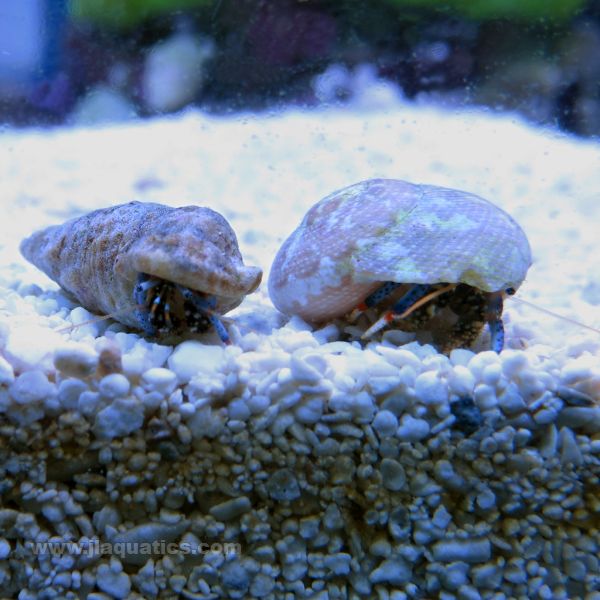
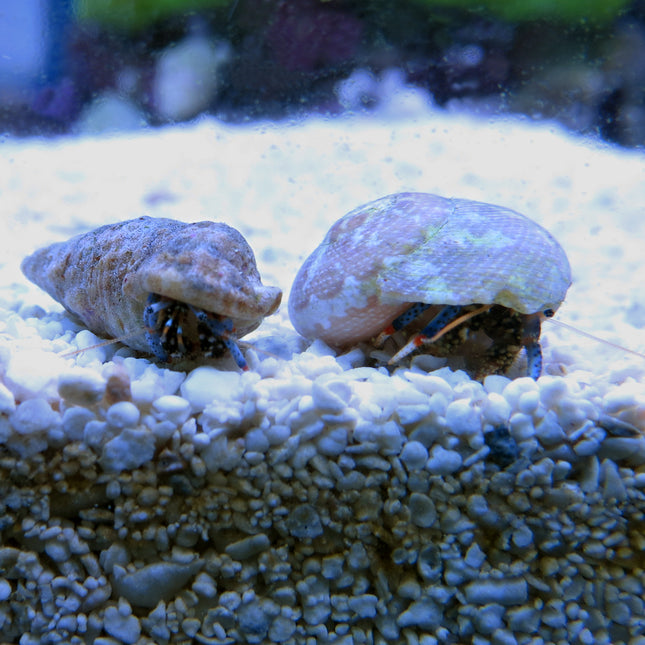
Blue Leg Hermit Crab
Hermit crabs need to live inside of a snail shell in order to keep their soft bodies safe. Even with many shells available hermit crabs will occasionally kill snails in order to take their shell. Please ask our staff and we will be happy to supply you with some empty shells.This is one of our most popular hermit crabs. It is colorful, stays small, and eats a wide variety of algae including some hair algae. It is typically imported from Florida. It is considered reef safe, however it is an opportunistic omnivore and will take food where it can find it. It will also eat fish food, detritus and anything else edible.
$2.95


Astrea Snail
The popular Astrea snail has a pointy white shell often covered in coralline algae. It is a terrific algae eater for the glass and rocks and grows to 1 inch. It is commonly available from Florida. It should be placed right side up on the sand near the glass after acclimation. It is adapted to rocky habitats; if it falls onto its back on the aquarium's sand it is not physically able to flip over and must be assisted. Snails are extremely sensitive to changes in water quality.
$3.95

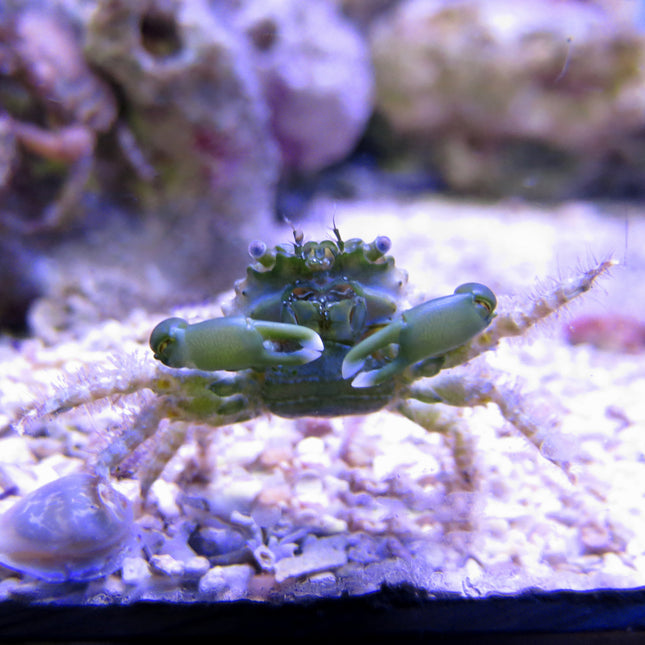
Emerald Crab - Green
The Emerald crab is famous for its voracious appetite for algae, especially bubble and hair algae and some macroalgae. It one of the most reef safe crabs, only bothering corals when food is in short supply. Its flattened claws are specially designed to pick algae off of rocks. It does not typically bother any other animals; however it is opportunistic and weakened tank mates may become fair game. It grows up to 2 inches and is imported from Florida.
$9.45

Nassarius Snail - Large
This efficient scavenging snail hides under the sand, emerging at feeding time to consume fish food and detritus. It grows to 1 inch and poses no threat to other aquarium inhabitants. It should be placed right side up on the sand after acclimation. Snails are extremely sensitive to changes in water quality.
$3.95


Peppermint Shrimp
Shrimp are active, entertaining and easy to keep. They shed their shells as they grow, and afterwards need to hide in the rock until their new shell hardens. Shrimp are highly excitable when food is present, and will do anything to get it. Some species may pester corals by attempting to reach food the coral has eaten. In this situation the shrimp should be provided food first. Large individuals may catch and consume smaller species.Ours is the true Caribbean Peppermint from our trusted Florida supplier: guaranteed to eat Aiptasia anemones. The trick is to limit the amount of fish food available to the shrimp, who may not hunt anemones on a full stomach. The shrimp also relies on its own kind for assistance in killing the stinging anemones. It may pester other, larger anemones, and occasionally corals such as zoanthids, but typically ignores all other aquarium inhabitants. It likes to rest upside down in caves in groups, often waving its body back and forth. It is not to be confused for the superficially similar Camel shrimp. The Peppermint shrimp grows up to 1.5 inches.
$23.95
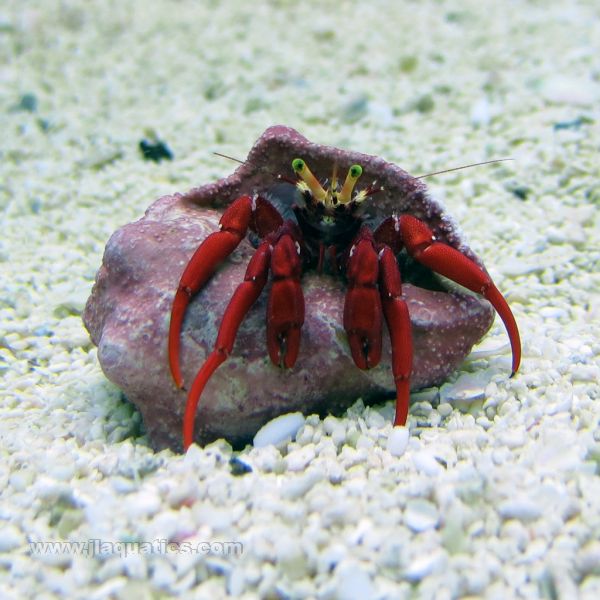
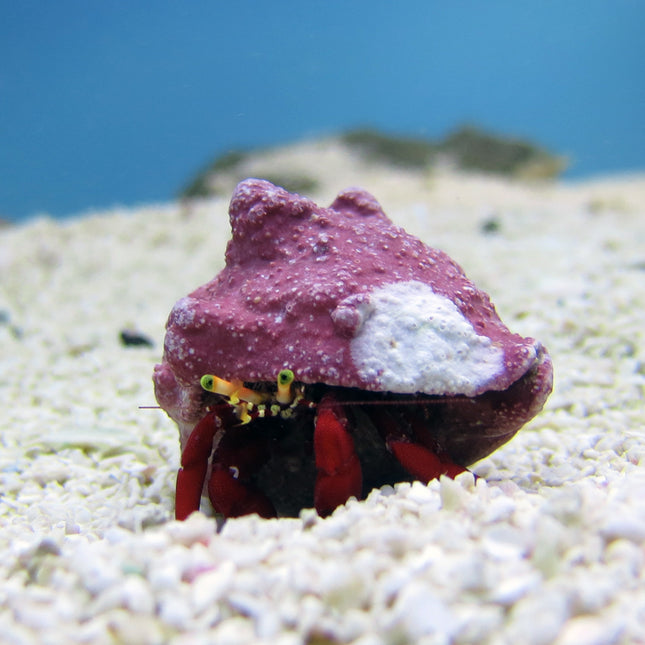
Red Scarlet Hermit Crab
Hermit crabs need to live inside of a snail shell in order to keep their soft bodies safe. Even with many shells available hermit crabs will occasionally kill snails in order to take their shell. Please ask our staff and we will be happy to supply you with some empty shells.This brightly colored crab from Florida makes a terrific addition to a clean-up crew. It is a medium sized crab that eats a wide variety of algae including some hair algae. It may hide during the day but is quite active at night. It is considered reef safe, however it is an opportunistic omnivore and will take food where it can find it. It will also eat detritus, algae, fish food, and anything else edible.
$9.95


Cerith Snail - Black
The popular Cerith snail has a pointy black shell with white speckles. It is a terrific algae eater for the sand and lower areas of the aquarium; it grows to 1 inch. It is commonly available from Florida. It should be placed right side up on the sand after acclimation. The shape of its shell helps ensure it does not become trapped upside down like some other snails. Snails are extremely sensitive to changes in water quality.
$3.95


Bumble Bee Snail
The attractive Bumble Bee snail has a jet black shell with bright yellow stripes. It actively patrols the rocks and sand in search of detritus and fish food to eat. It may also consume worms and micro-fauna in the substrate. It grows to 1 inch. It is commonly available from the Philippines. It should be placed right side up on the sand after acclimation. Snails are extremely sensitive to changes in water quality.
$3.95


Turbo Snail
The Turbo snail is well known as a fast moving snail that makes quick work of algae in the aquarium. Its rounded shell usually grows to 2 or 3 inches, although some species may grow even larger. Its operculum, or trap door, is smooth, unlike its Mexican cousins who have a swirl pattern. It should be placed right side up on the sand after acclimation. It is adapted to rocky habitats; if it falls onto its back on the aquarium's sand it is not physically able to flip over and must be assisted. Snails are extremely sensitive to changes in water quality.
$7.95

Nassarius Snail
This minute snail hides under the sand, emerging at feeding time to consume fish food and detritus. Its small size allows it to enter tiny crevices in the live rock. This efficient clean-up critter grows to 1/2 inch and poses no threat to other aquarium inhabitants. It is typically imported from Florida. It should be placed right side up on the sand after acclimation. Snails are extremely sensitive to changes in water quality.
$2.95


Orange Lip/Strawberry Conch
One of the best sand-sifting snails, the Orange Lip, or Strawberry conch stays small and eats lots of algae. It moves with a hopping motion and may hide under the substrate. It is regularly imported from the Philippines. It is usually available as a 1 inch snail which may grow up to 3 inches long
$15.45
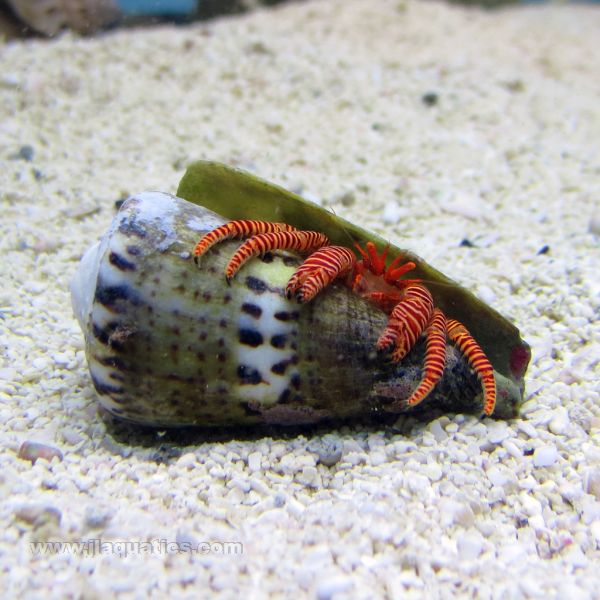

Halloween Hermit Crab
Hermit crabs need to live inside of a snail shell in order to keep their soft bodies safe. Even with many shells available hermit crabs will occasionally kill snails in order to take their shell. Please ask our staff and we will be happy to supply you with some empty shells.This colorful crab from Hawaii is bright scarlet with orange bands. It grows to a medium size and needs shells with a narrow opening such as conch shells. It is well known to eat many types of algae including some hair algae. It is considered reef safe, however it is an opportunistic omnivore and will take food where it can find it. It will also eat detritus, fish food, and anything else edible.
$8.95


Pistol Shrimp - Tiger
Shrimp are active, entertaining and easy to keep. They shed their shells as they grow, and afterwards need to hide in the rock until their new shell hardens. Shrimp are highly excitable when food is present, and will do anything to get it. Some species may pester corals by attempting to reach food the coral has eaten. In this situation the shrimp should be provided food first. Large individuals may catch and consume smaller species.An attractive shrimp with fine red stripes, it makes the perfect pairing with a shrimp goby. It may be kept without its fish companion but is extremely secretive on its own. This species grows to 3 inches.We recommend a shrimp and its goby partner be added to the aquarium at the same time; it is best if they are placed in a net together and gently lowered to the aquarium bottom. The hard-working shrimp will excavate a burrow under the sand for it and the fish to live in, consisting of several tunnels, entrances and exits. The sharp-eyed goby stands guard at one of the entrances and keeps an eye out for threats. At nighttime or when a tunnel is not being used the shrimp will block it off with shells and small rocks. It is important to provide deep sand of at least three inches and plenty of shells and crushed coral of various sizes so the shrimp has enough building material to create a stable dwelling. Rocks should be placed on the aquarium glass and sand poured around them to eliminate the danger of a cave-in when the shrimp excavates. The pistol shrimp has an enlarged claw which may make a clicking or popping sound.If more than one pistol shrimp is to be kept in the same aquarium we recommend space enough to accommodate at least 24 inches between burrows. They are typically peaceful with all tank mates, although there is a small threat to other crustaceans if the pistol shrimp is not getting enough food. To minimize this threat any sort of fish food may be placed at the tunnel entrance for the shrimp to collect.
$26.95
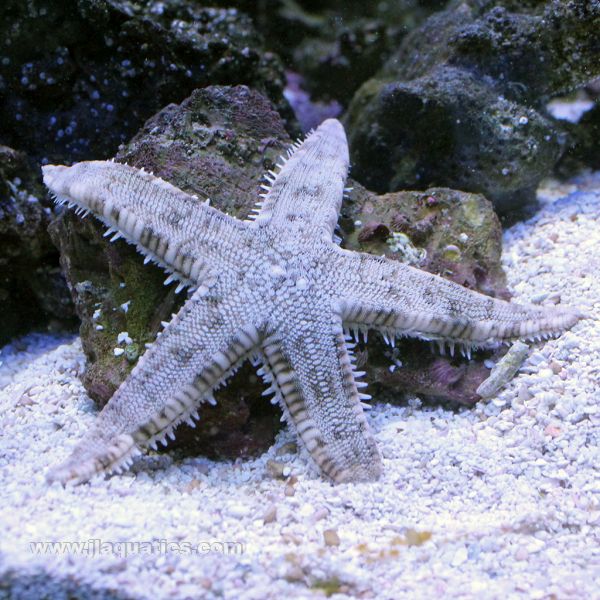
White Sand Star
The White Sand starfish is well camouflaged to blend into its habitat. It makes a living sifting through the sand, cleaning and aerating it. It may hide just under the surface or crawl on top of the substrate. Sand should be at least 3 inches deep, preferably deeper in order to provide enough natural food, which consists mainly of biofilm and microalgae. It is completely reef safe and does not bother corals. If it is kept with competing animals, such as its own kind, sand dollars or cucumbers, the aquarium must be large enough to support all animals.Echinoderms such as starfish are extremely sensitive to changes in the water quality. They require well established aquariums of at least 6 months for both water stability and sufficient food supply. It grows up to 12 inches and needs an aquarium at least 100 gallons.
$26.45


Ring Cowrie
This exceptional snail is both beautiful and hard working. It eats many types of algae such as hair and diatoms, and is not usually targeted by hermit crabs. Its smooth shell is covered by its fleshy mantel when the snail is active. It is known to breed in the aquarium and may sit on top of its eggs to protect them. It grows to 1 inch and is perfect for even small aquariums. It should be placed right side up on the sand after acclimation.
$13.95


Feather Duster - Giant
The giant feather duster may grow up to 7 inches across and comes in a wide variety of colors in alternating stripes. It may be any combination of chocolate, cream, orange, pure white or black.Feather duster worms are filter feeders and require frequent additions of phytoplankton in order to thrive. The visible part of the worm is its feeding tentacles and the rest of the worm is hidden within a protective tube. If there is not enough food it may 'drop' its tentacles and attempt to re-grow them. If stressed it may leave its tube, but if undisturbed it can create a new one. It is imperative when placing the worm into the water to rotate it to remove all air bubbles which may have become trapped inside the tube. It is completely harmless and has no sting. It should never be housed with predatory animals such as butterflyfish.
$15.45

Cerith Snail - White
The popular Cerith snail has a pointy grey shell. It is a terrific algae eater for the sand and lower areas of the aquarium; it grows to 1 inch. It is commonly available from Florida. It should be placed right side up on the sand after acclimation. The shape of its shell helps ensure it does not become trapped upside down like some other snails. Snails are extremely sensitive to changes in water quality.
$3.95
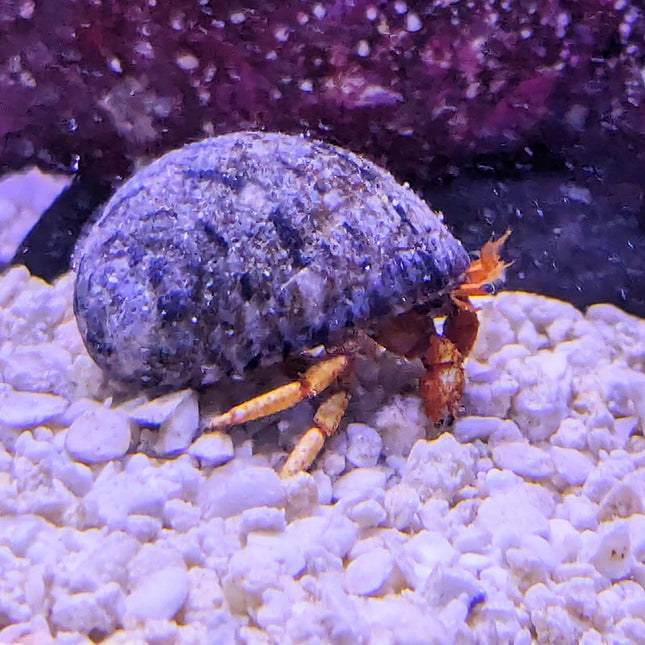
Red Dwarf Hermit Crab
Hermit crabs need to live inside of a snail shell in order to keep their soft bodies safe. Even with many shells available hermit crabs will occasionally kill snails in order to take their shell. Please ask our staff and we will be happy to supply you with some empty shells.The Red Dwarf Hermit is is a small to sized hermitcrab that eats a wide variety of algae including some hair algae. As it's name implies you can expect this hermit to have bright red or orange/red legs and is considered to be reef safe, however it is an opportunistic omnivore and will take food where it can find it. It will also eat detritus, algae, fish food, and anything else edible.The Red Dwarf Hermit will spend the majority of it's time on the rock work picking at algae.
$7.45
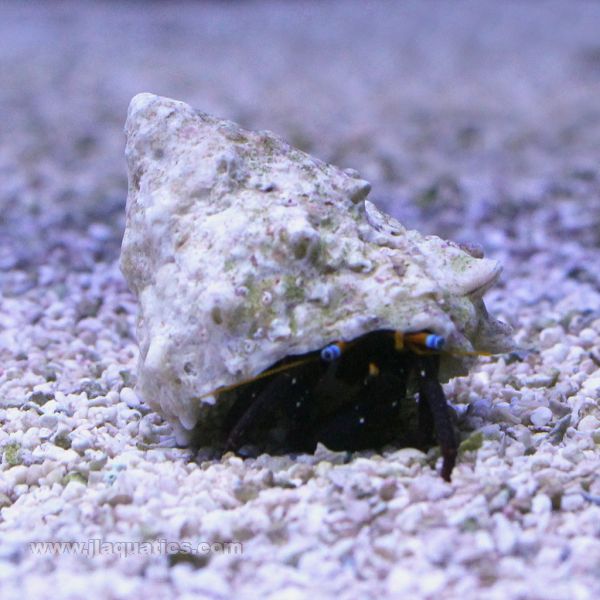
Blue Eyed Hermit Crab
Hermit crabs need to live inside of a snail shell in order to keep their soft bodies safe. Even with many shells available hermit crabs will occasionally kill snails in order to take their shell. Please ask our staff and we will be happy to supply you with some empty shells.This crab has earthy colored claws and bright baby blue eyes. It is an opportunistic omnivore and may eat corals, fish food, detritus, algae and more.
$4.95
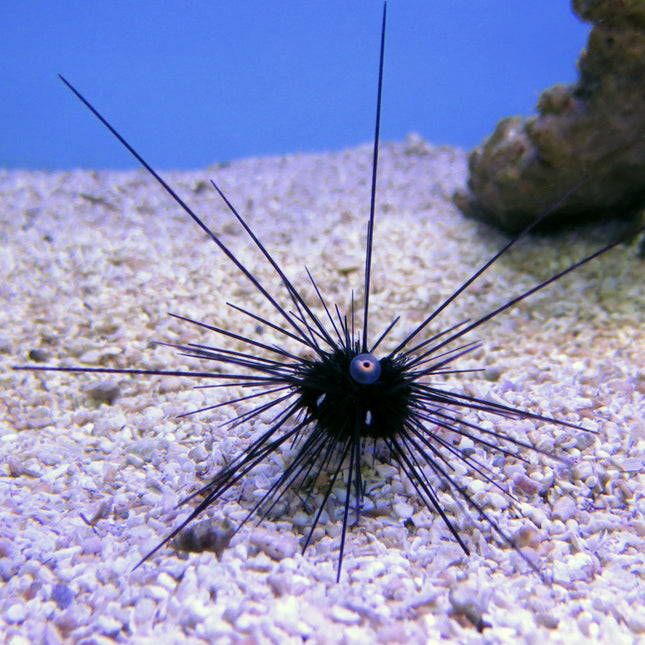
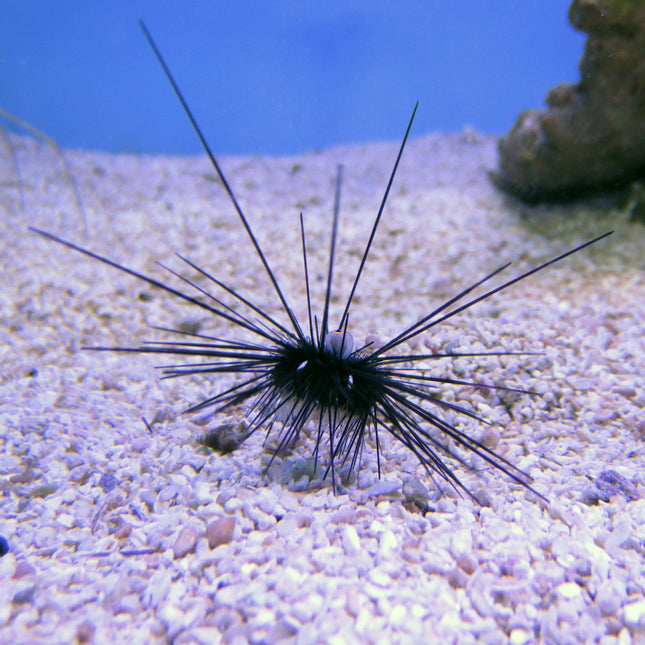
Longspine Urchin
This amazing creature grows exceptionally long spines for protection. It is typically black, although sometimes the spines are striped with white.It is most active at night, and has a voracious appetite for algae, including hair algae - if there is not enough natural food available it may be fed dried algae sheets. It is very reef safe, and only bothers corals if it is starving.Its spines are easily broken and may easily puncture skin causing painful wounds. Broken spines will grow back quickly.This urchin can grow to 12 inches.
$29.95

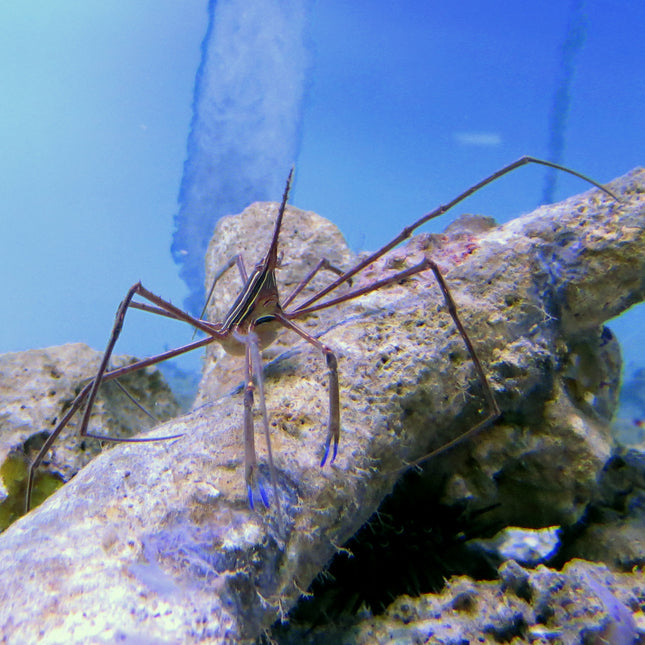
Arrow Crab
Spindly legs and a pointy head make this crab look more like a spider. Its long legs give it a good vantage point to search for its preferred prey- bristle worms. It may decimate populations of these useful scavengers in small aquariums, so is normally best kept in large tanks. It will also eagerly feed on fish food. Because of its large size and strength it may prey on other crustaceans, even those of similar size such as Coral Banded shrimp. It can grow up to a 6 inches leg span.
$37.45

Condylactis Anemone - Common
Anemones have a central mouth surrounded by stinging tentacles which can capture small creatures and deliver them to the mouth. The sting is often quite strong and capable of damaging corals and injuring fish. Small fish such as firefish and dragonets may accidently swim directly into the anemone and be killed. Large anemones such as carpets may even kill larger fish. The addition of a night light greatly aids fish in avoiding the anemones. The tentacles are often very sticky and can cause painful sores. Some animals are specially adapted to live within anemones, such as Periclimenes shrimp and Porcelain crabs.Anemones receive most of their energy from the light, which should be very bright. Metal halide is the preferred lighting for most anemones. Feeding should be at least twice weekly and consist of small meaty items such as Mysis or chopped krill. Large specimens may take diced fish.The foot of the anemone enables them to adhere to glass and also to crawl around the aquarium. They can also float in the water to move quickly. Newly introduced specimens often wander for some time before settling down. At any time it may relocate, and is prone to being sucked into powerheads; all pumps should be screened for safety. Its foot is delicate and should never be damaged. Protein skimming is recommended to oxygenate the water sufficiently. Stable water conditions are important, and anemones are only recommended for mature aquariums.This Caribbean anemone may grow up to 12 inches; common specimens are typically a cream to white color. It is one of the easiest anemones to keep, but still demands stable conditions. It prefers to hide its foot in the rockwork. It does not usually host clownfish, although occasionally Clarkii complex clownfish may host with it.
$44.45
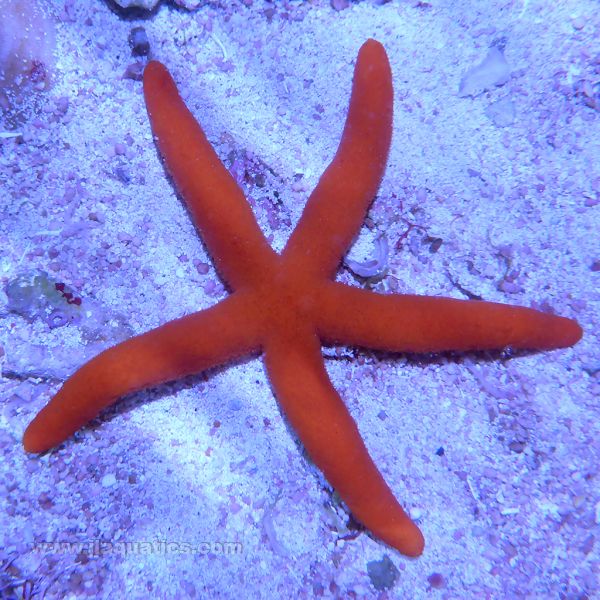
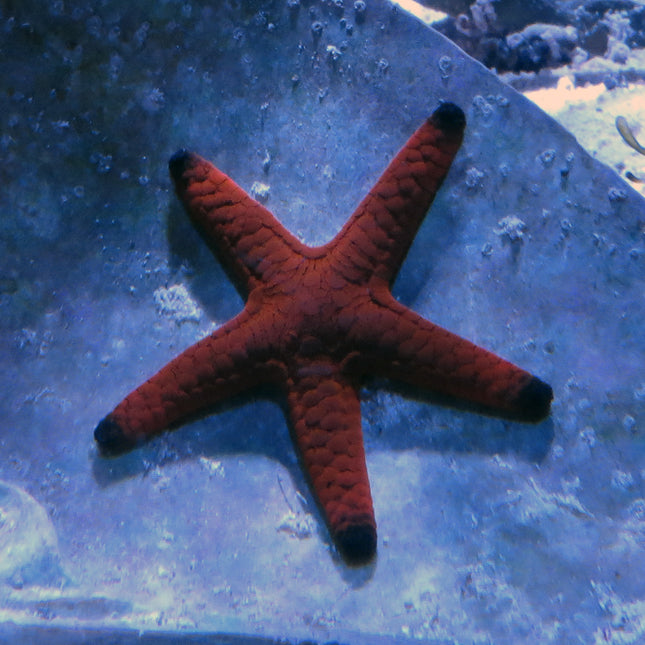
Red Reef Starfish
This brightly colored animal may be solid ruby red, sometimes with black tips on its arms, or may be bright orange. It is usually found crawling on the glass or live rock searching for food. A sand substrate helps to generate enough natural food, which consists mainly of biofilm and microalgae. It is completely reef safe and does not bother corals. If it is kept with competing animals, such as other starfish, the aquarium must be large enough to support all animals.Echinoderms such as starfish are extremely sensitive to changes in the water quality. They require well established aquariums of at least 6 months for both water stability and sufficient food supply. It grows up to 6 inches and needs an aquarium at least 100 gallons.
$44.45
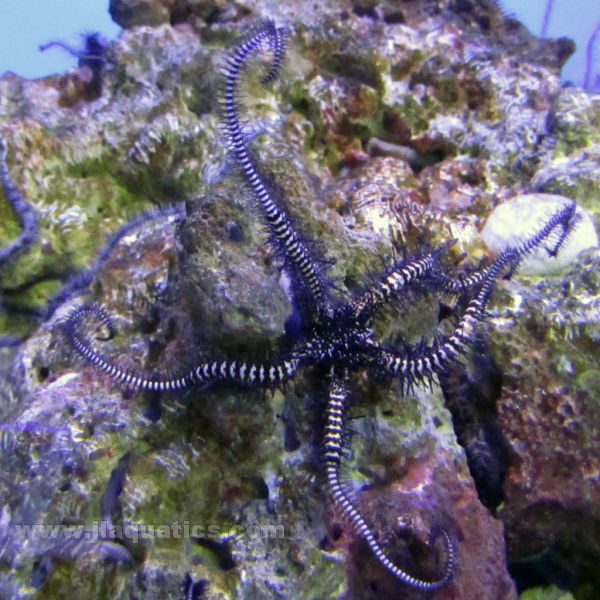
Brittle Star - Black/Pink
The Brittle star is usually jet black or light pink, sometimes with light and dark banding. Its arms are covered in course bristles. It gets its name from the fact that, if threatened, its arms may fall off or break into pieces. It spends most of its time hiding inside the rock with its arms sticking out, waiting for some fish food to drift by. It is an efficient scavenger and can clean the rocks of leftover food and detritus. It is completely reef safe and does not bother corals. It is safe with fish, although very small sleeping fish may occasionally be at risk. Because it eagerly consumes fish food it is one of the easiest starfish to keep.Echinoderms such as starfish are extremely sensitive to changes in the water quality. They require well established aquariums of at least 6 months to ensure water stability. It grows up to 10 inches and needs an aquarium at least 50 gallons.
$29.45


Bubble Anemone - Green
Anemones have a central mouth surrounded by stinging tentacles which can capture small creatures and deliver them to the mouth. The sting is often quite strong and capable of damaging corals and injuring fish. Small fish such as firefish and dragonets may accidently swim directly into the anemone and be killed. Large anemones such as carpets may even kill larger fish. The addition of a night light greatly aids fish in avoiding the anemones. The tentacles are often very sticky and can cause painful sores. Some animals are specially adapted to live within anemones, such as Periclimenes shrimp and Porcelain crabs.Anemones receive most of their energy from the light, which should be very bright. Metal halide is the preferred lighting for most anemones. Feeding should be at least twice weekly and consist of small meaty items such as Mysis or chopped krill. Large specimens may take diced fish.The foot of the anemone enables them to adhere to glass and also to crawl around the aquarium. They can also float in the water to move quickly. Newly introduced specimens often wander for some time before settling down. At any time it may relocate, and is prone to being sucked into powerheads; all pumps should be screened for safety. Its foot is delicate and should never be damaged. Protein skimming is recommended to oxygenate the water sufficiently. Stable water conditions are important, and anemones are only recommended for mature aquariums.The Bubble Tip anemone is the best first choice anemone as it tolerates a wide variety of lighting and aquarium conditions. It may grow up to 12 inches but typically divides into two or more specimens before reaching a large size. Its tentacles may take on a bulbous appearance or be long and thin. Both shapes can be found on healthy specimens, and the shape may change depending on the animal's mood.Bubble tip anemone prefers to hide its foot in the rockwork. It may host with any type of clownfish, hosting easiest with Percula, Maroon, Ephippium, Tomato and Clarkii complexes.
$53.95


Harlequin Shrimp
Shrimp are active, entertaining and easy to keep. They shed their shells as they grow, and afterwards need to hide in the rock until their new shell hardens. Shrimp are highly excitable when food is present, and will do anything to get it. Some species may pester corals by attempting to reach food the coral has eaten. In this situation the shrimp should be provided food first. Large individuals may catch and consume smaller species.The Harlequin shrimp is a strikingly beautiful animal related to the Bongo shrimp. It is a specialized predator and only eats starfish, including Asterina stars, but also larger species such as linkia, chocolate chip and sand sifting species. Females are larger and have spots under their tails which males do not. Its claws are designed for flipping over starfish, and when a large starfish is chosen the shrimp will attempt to keep it alive as long as possible while it is eaten. The Harlequin shrimp grows to 2 inches and is known to live up to 6 years.
$73.45


Black Knobby Cucumber
Echinoderms such as cucumbers are extremely sensitive to changes in the water quality. They require well established aquariums for both water stability and sufficient food supply.The Black Knobby cucumber is pure black with small spines along its sides. It is a useful sand stirring animal which digs down into the deeper layers of substrate. It ingests sand and digests any organic matter. Echinoderms such as cucumbers are extremely sensitive to changes in the water quality. They require well established aquariums for both water stability and sufficient food supply. Sand should be minimum 3 inches deep. It may grow up to 12 inches long and needs an aquarium at least 100 gallons.
$37.45 $24.99


Carpet Anemone - Green (Indian Ocean)
Anemones have a central mouth surrounded by stinging tentacles which can capture small creatures and deliver them to the mouth. The sting is often quite strong and capable of damaging corals and injuring fish. Small fish such as firefish and dragonets may accidently swim directly into the anemone and be killed. Large anemones such as carpets may even kill larger fish. The addition of a night light greatly aids fish in avoiding the anemones. The tentacles are often very sticky and can cause painful sores. Some animals are specially adapted to live within anemones, such as Periclimenes shrimp and Porcelain crabs.Anemones receive most of their energy from the light, which should be very bright. Metal halide is the preferred lighting for most anemones. Feeding should be at least twice weekly and consist of small meaty items such as Mysis or chopped krill. Large specimens may take diced fish.The foot of the anemone enables them to adhere to glass and also to crawl around the aquarium. They can also float in the water to move quickly. Newly introduced specimens often wander for some time before settling down. At any time it may relocate, and is prone to being sucked into powerheads; all pumps should be screened for safety. Its foot is delicate and should never be damaged. Protein skimming is recommended to oxygenate the water sufficiently. Stable water conditions are important, and anemones are only recommended for mature aquariums.A spectacular animal that often grows to 24 inches or more and makes an incredible display. It prefers to bury its foot into deep sand. Its tentacles are very short and numerous. Its bright emerald color is one most widely available varieties. It may host with many clownfish species, hosting easiest with Clarkii, Percula, Saddleback, Ephippium and Skunk complex clownfish.
$183.45 - $227.95


Rock Anemone - Ultra
Anemones have a central mouth surrounded by stinging tentacles which can capture small creatures and deliver them to the mouth. The sting is often quite strong and capable of damaging corals and injuring fish. Small fish such as firefish and dragonets may accidently swim directly into the anemone and be killed. Large anemones such as carpets may even kill larger fish. The addition of a night light greatly aids fish in avoiding the anemones. The tentacles are often very sticky and can cause painful sores. Some animals are specially adapted to live within anemones, such as Periclimenes shrimp and Porcelain crabs.Anemones receive most of their energy from the light, which should be very bright. Metal halide is the preferred lighting for most anemones. Feeding should be at least twice weekly and consist of small meaty items such as Mysis or chopped krill. Large specimens may take diced fish.The foot of the anemone enables them to adhere to glass and also to crawl around the aquarium. They can also float in the water to move quickly. Newly introduced specimens often wander for some time before settling down. At any time it may relocate, and is prone to being sucked into powerheads; all pumps should be screened for safety. Its foot is delicate and should never be damaged. Protein skimming is recommended to oxygenate the water sufficiently. Stable water conditions are important, and anemones are only recommended for mature aquariums.Rock Flower anemones may grow up to 8 inches and are one of the easiest species to keep. A smooth area around the mouth is surrounded by a ring of longer tentacles. Ultra specimens are brightly colored, usually multicolored, and may display colors not seen on other grades. It will usually bury its foot in the sand. Rock Flower anemones do not host with clownfish, but may become a safe haven for small shrimp and crabs.
$101.45


Spider Conch
This beautiful snail from the Philippines is a great algae eater for the lower areas of the aquarium. Its shell has long spikes sticking out from one side. Its heavy shell prevents it from climbing onto rocks but it has a long proboscis that can reach onto the glass. It moves with a hopping motion and may hide under the substrate. Its shell may grow up to 11 inch long.
$28.95
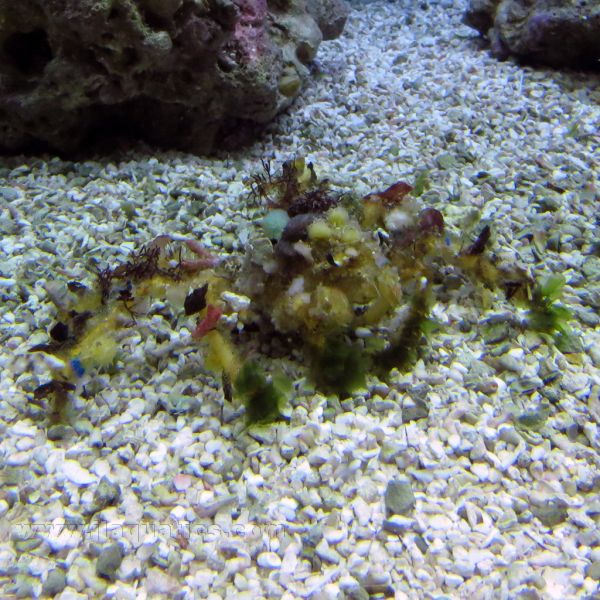
Decorator Crab
The Spider Decorator crab looks like an underwater tarantula covered in bits of live coral, macroalgae, sponges, shells, and any other small objects from its environment providing excellent camouflage. It is an opportunistic feeder and small or weakened tank mates may become fair game. It grows up to 4 inches and is easy to feed on fish food.
$29.45
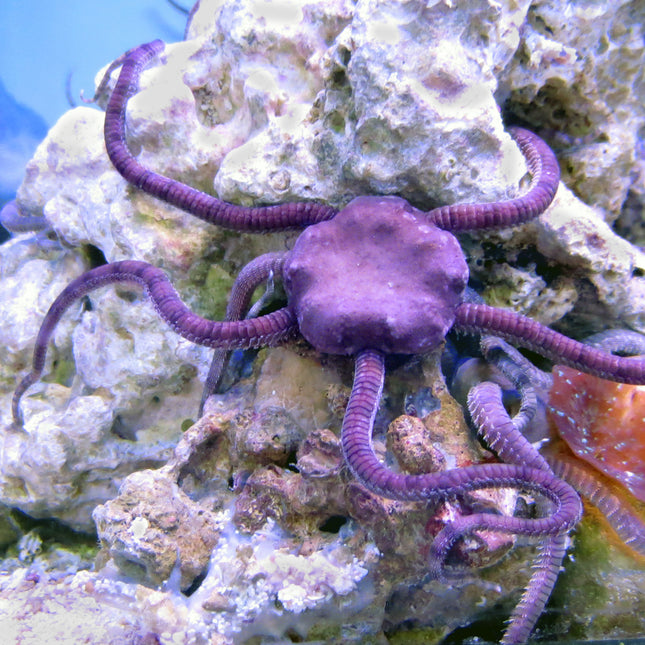
Serpent Star - Common
The Serpent star, or Smooth Brittle star, is usually found in colors such as cream, ash and pink, usually with light and dark banding. It spends most of its time hiding inside the rock with its arms sticking out, waiting for some fish food to drift by. It is an efficient scavenger and can clean the rocks of leftover food and detritus. It is completely reef safe and does not bother corals. Because it eagerly consumes fish food it is one of the easiest starfish to keep.Echinoderms such as starfish are extremely sensitive to changes in the water quality. They require well established aquariums of at least 6 months to ensure water stability. It grows up to 12 inches and needs an aquarium at least 50 gallons.
$29.45
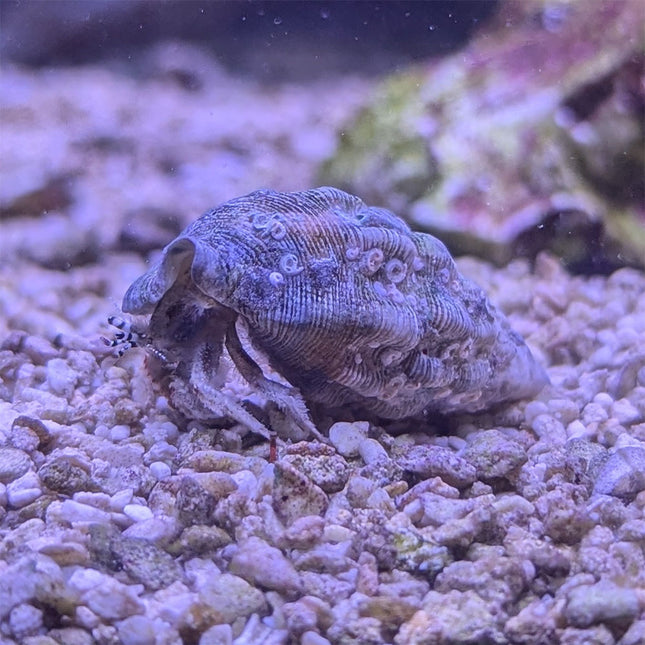
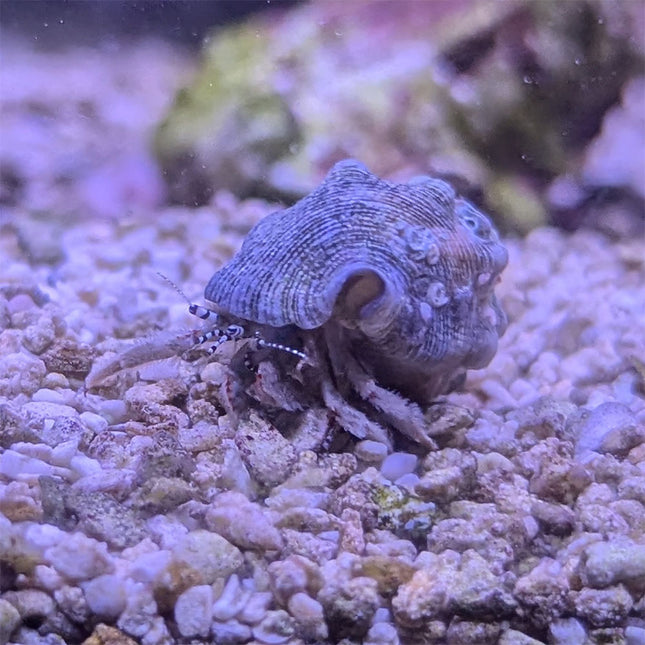
White Reef Hermit Crab
White Reef Hermit Crab
$3.95


Spiny Astrea Snail - Large
The Large Spiny Astrea snail eats many types of algae including hair algae and some macroalgae. Its shell is typically dark grey and has spikes all over. It may grow to 2.5 inches. It should be placed right side up on the sand after acclimation. It is adapted to rocky habitats; if it falls onto its back on the aquarium's sand it is not physically able to flip over and must be assisted. Snails are extremely sensitive to changes in water quality.
$6.95


$39.95
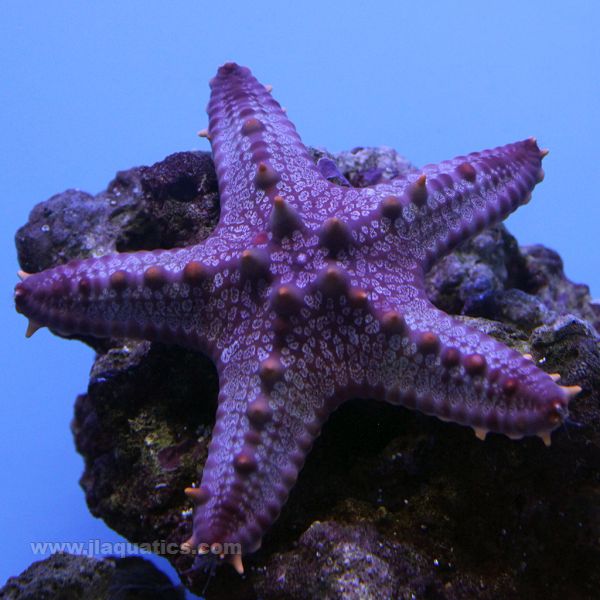
Red Spined Starfish
This delightful animal is typically cream colored with bright scarlet spines and stripes on its back. It is similar to the Chocolate Chip starfish. It is usually found crawling on the glass or live rock searching for food. In nature it lives on sandy substrate sea grass beds. It is not reef safe and may eat many types of sessile invertebrates such as corals, sponges and anemones. It can be fed pieces of chopped seafood on the sand with the starfish placed on top.Echinoderms such as starfish are extremely sensitive to changes in the water quality. They require well established aquariums of at least 6 months for both water stability and sufficient food supply. It grows up to 12 inches and needs an aquarium at least 100 gallons.
$39.95
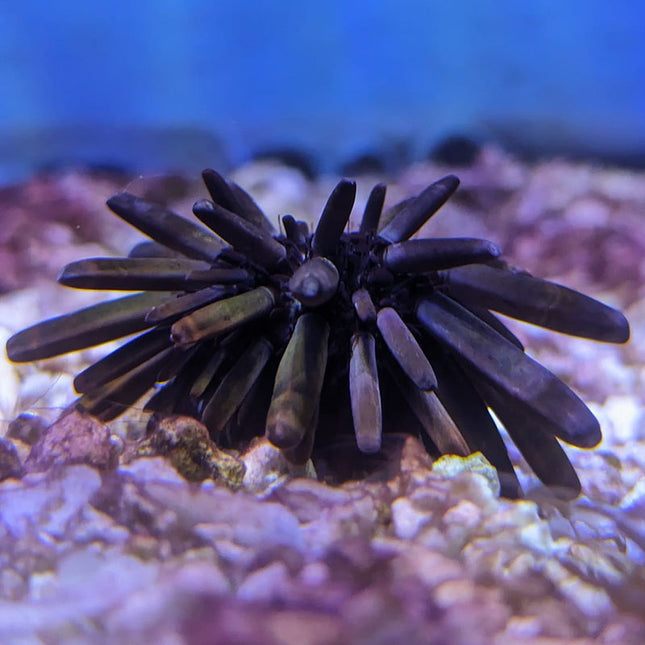
$29.45
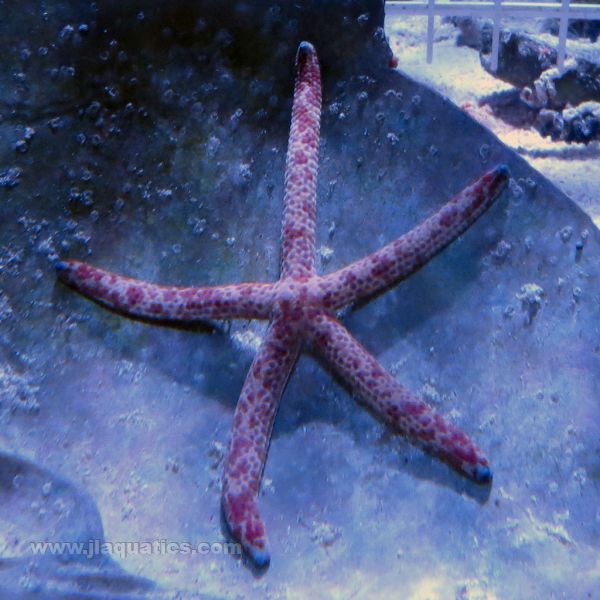
Linckia Starfish - Multiflora
Also known as the Multicolor starfish, it is cream colored with scarlet red polka dots on its back. It is usually found crawling on the glass or live rock searching for food. A sand substrate helps to generate enough natural food, which consists mainly of biofilm and microalgae. It is completely reef safe and does not bother corals. If it is kept with competing animals, such as other starfish, the aquarium must be large enough to support all animals. This is one of the easiest starfish to keep, although it is still only recommended for experienced aquarists.Echinoderms such as starfish are extremely sensitive to changes in the water quality. They require well established aquariums of at least 6 months for both water stability and sufficient food supply. It grows up to 4 inches and needs an aquarium at least 75 gallons.
$46.95

































































